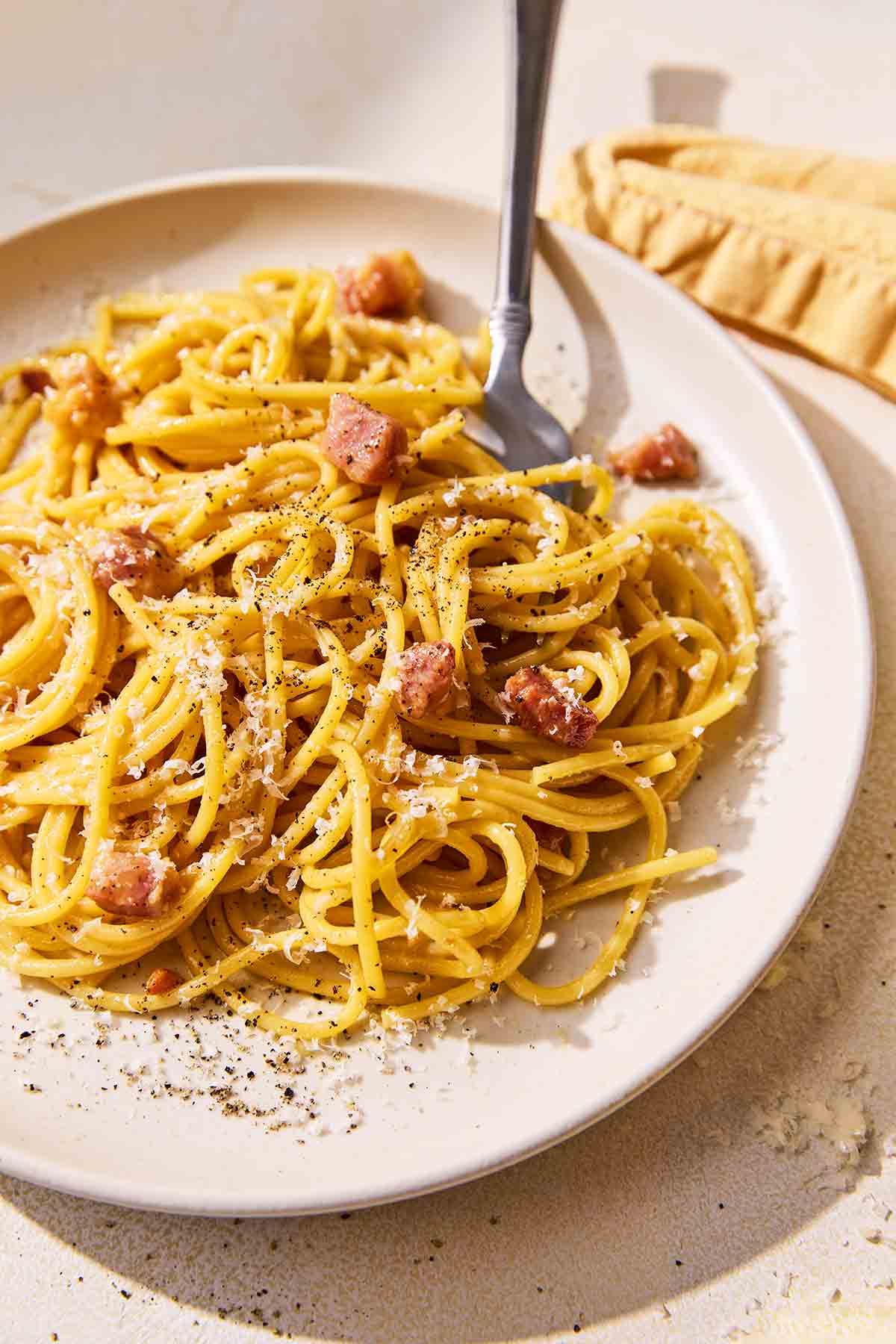
This knock-it-out-of-the-park, authentic spaghetti alla carbonara recipe calls for extra egg yolk, which lends a silken richness and lusciousness to the dish. If you want a traditional version, use four whole eggs. I’ve also seen Italian cooks use an extra large egg yolk per person, which is super luxurious. Whatever you do, please forgo cream, peas, garlic, etc. They’re wonderful; they’re just not part of the classic recipe.
Also, a lot of readers have asked whether they can use freshly made pasta. You can, but I find that using premium dried pasta made from durum or semolina wheat really helps the sauce to cling.
Video: How To Make Spaghetti Carbonara
Jump To

Why Our Testers Loved This
My testers unanimously agreed that this authentic spaghetti carbonara recipe is a keeper thanks to its easy preparation and simple ingredient list. Alexander C. calls it a “creamy, porky bowl of pasta love.” I can’t argue with that.
Notes on Ingredients
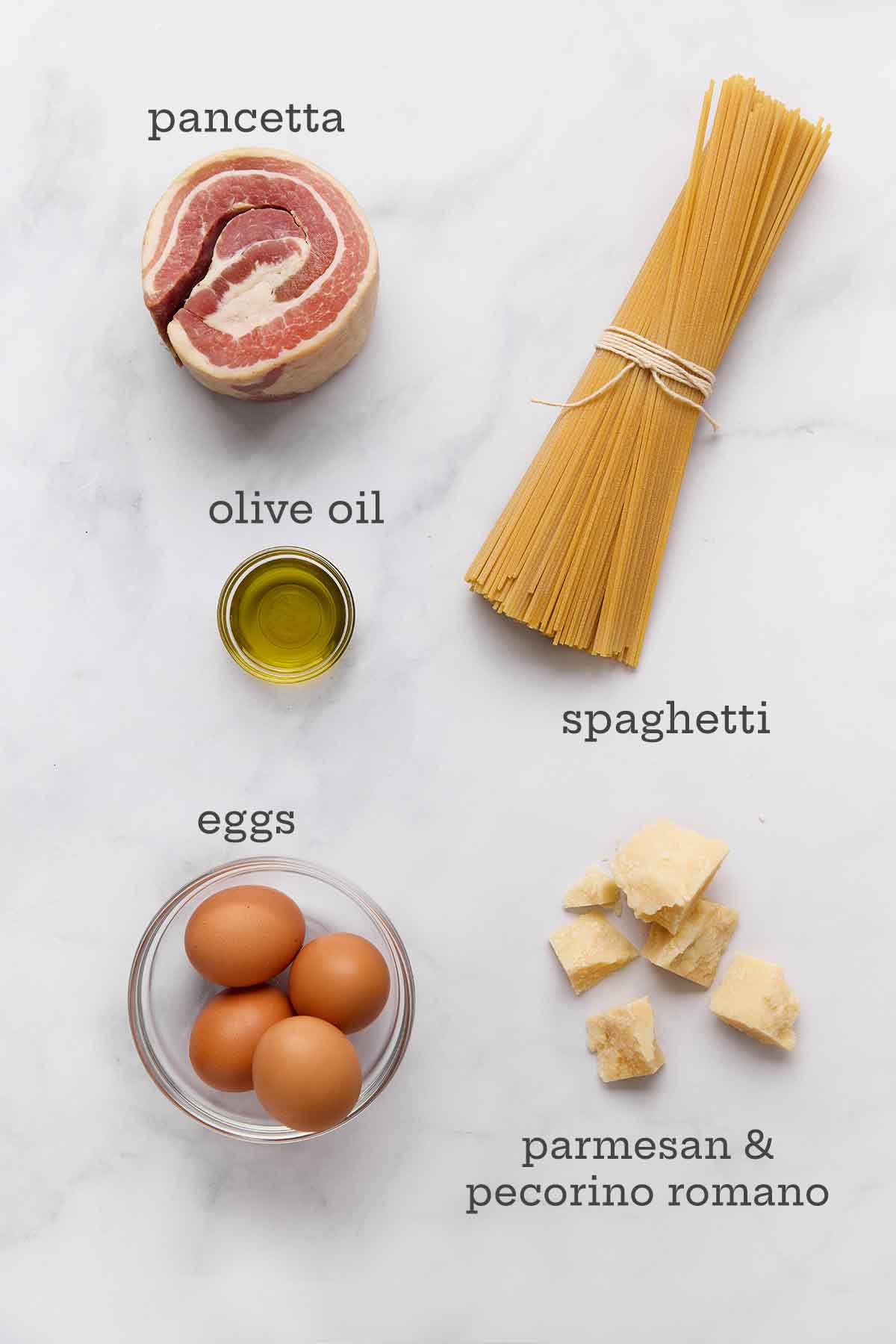
- Pancetta—Guanciale is the classic meat in carbonara, but it can be hard to find. You can use pancetta (pork belly) or slab bacon in its place.
- Pasta—For this recipe, I recommend using excellent-quality dried pasta (pasta secca) preferably made with bronze dies. Pasta extruded through bronze dies has a rougher texture that helps sauces to hang on.
- Cheese—For the best flavor, this recipe calls for a combo of Parmigiano-Reggiano and Pecorino Romano. Always use freshly grated cheese, as the packaged, pre-grated stuff doesn’t melt well and…tastes like sawdust.
How to Make Authentic Spaghetti Carbonara
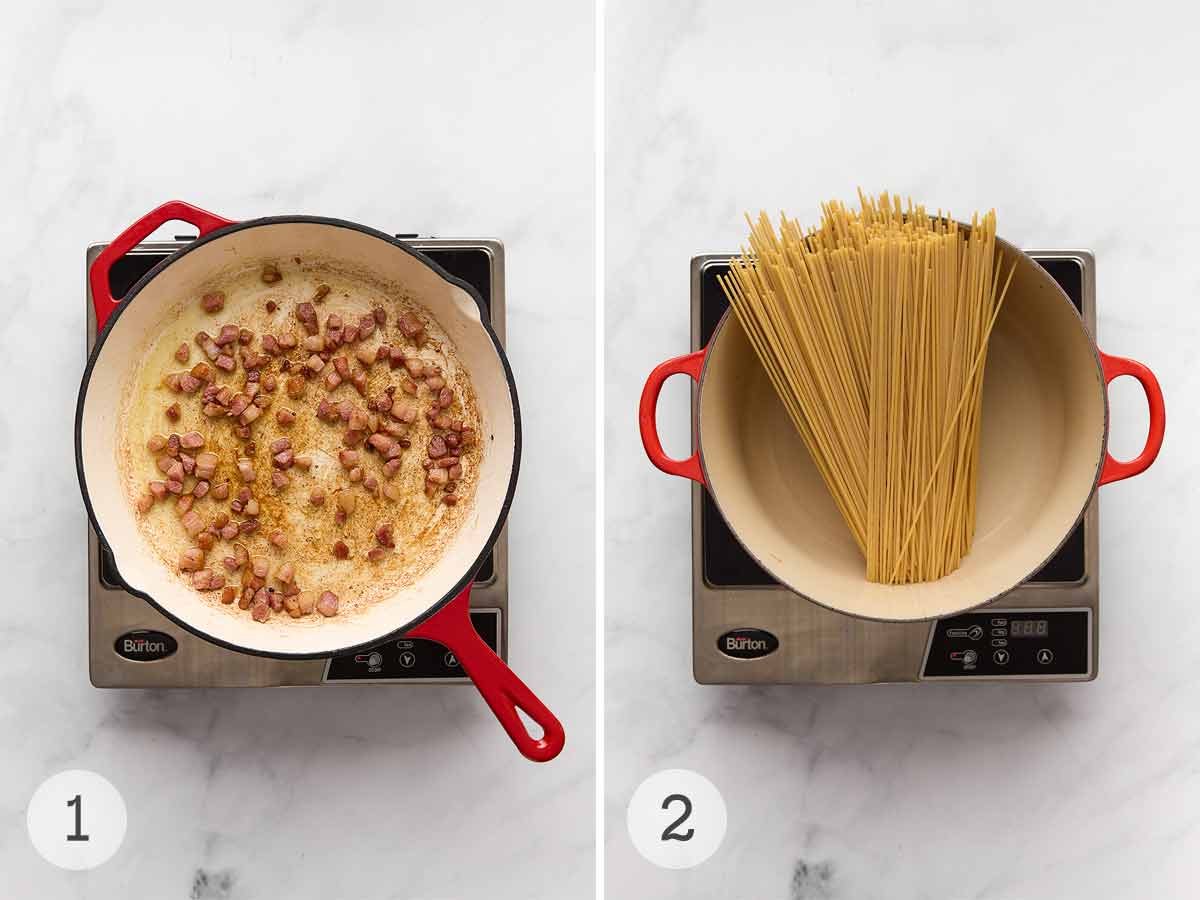
- Heat the oil in a large skillet over medium heat. Cook the pancetta in the hot oil until crisp.
- Boil the spaghetti in a large pot of salted water until al dente.
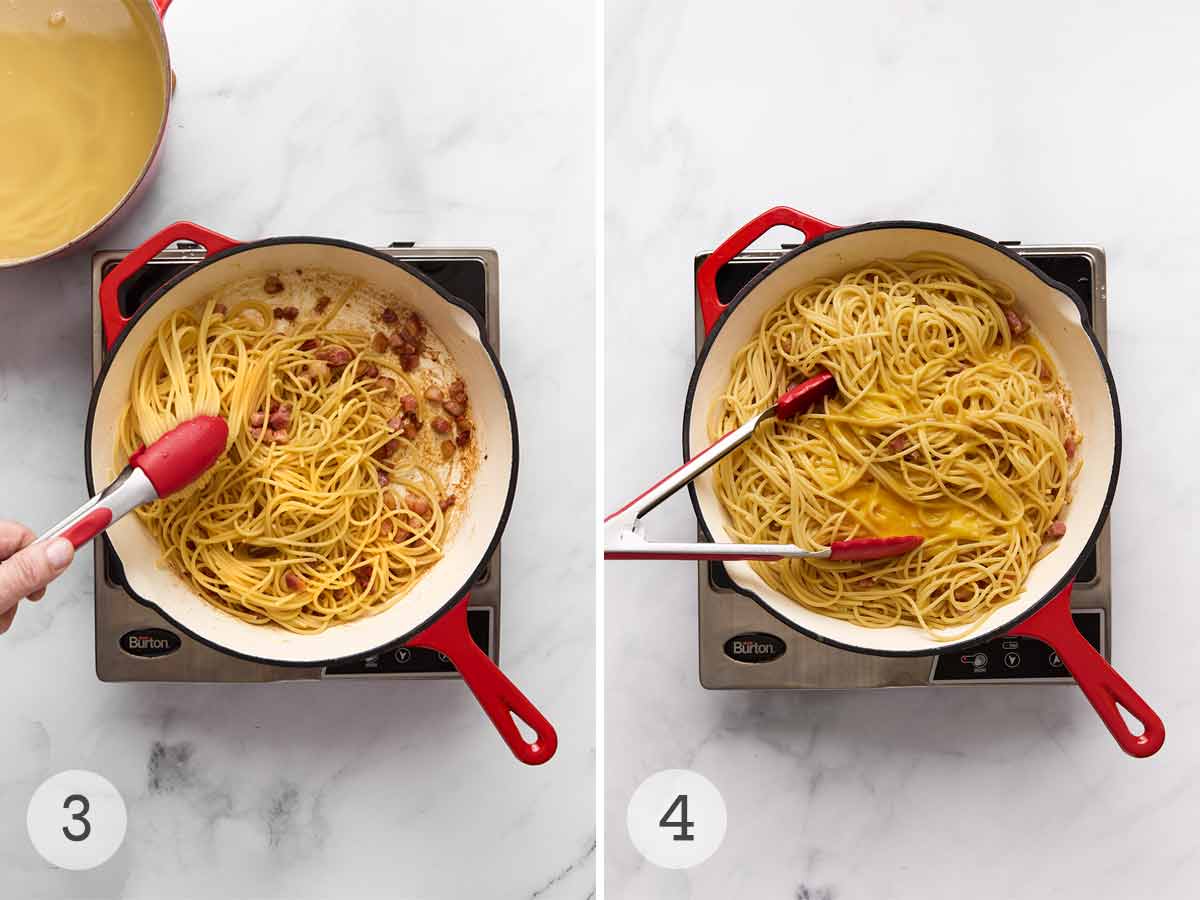
- Grab big bunches of spaghetti with tongs and transfer them to the skillet with the pancetta.
- Add the eggs and half of the cheese to the pasta in the skillet and toss well. Add some pasta water, as needed, until the pasta is creamy.

- Season with pepper and serve with the remaining cheese.
Common Questions
Guanciale, which comes from the cheek of the pig, is a richly fatty piece of meat that is often cured. It’s usually found in Italian pasta dishes from Umbria and Lazio, in central Italy. Two of the most famous and beloved dishes that call for guanciale are spaghetti alla carbonara and Bucatini All’ Amatriciana.
Absolutely, 100 percent, utterly no. There is no cream in the dish. The creaminess comes from the proper cooking of the eggs with pasta cooking water, making it luscious, creamy, and addictive. Also, while I’m at it, there are no peas, garlic, cinnamon, or nutmeg in carbonara, either.
“Carbonara” comes from the Italian word carbonaro, meaning “coal burner.” There’s a legend, which most believe to be apocryphal, that says the dish was created as an easy-to-make, stick-to-your-ribs meal men who working outside all day long could make for themselves. The requisite ground pepper is supposedly a nod to coal dust that landed on the dish as the miners ate.
The more widely accepted origin of the dish is that American soldiers during the Second World War brought their taste for bacon and eggs to Europe, and hence the dish was created to sate ally tastes.
Pro Tips
- Remember, this spaghetti alla carbonara recipe contains raw eggs. So, use care if making the dish for the very young, the very old, the very pregnant, or the very immuno-compromised. For the rest of you, sit down to this outrageously easy and traditional Italian carbonara recipe with gusto.
- Have all your ingredients prepped and ready to go, as this pasta dish comes together in just minutes once you begin cooking.
Storage and Reheating
Spaghetti alla carbonara is best enjoyed immediately after cooking, but leftovers can be stored in a sealed container in the fridge for up to 2 days. If you know you’ll have leftovers, save some pasta water for reheating.
Gently reheat the carbonara in a skillet over very low heat, stirring frequently. Add just enough pasta cooking water to loosen the pasta and achieve a creamy consistency. Don’t be tempted to speed things up by cooking over medium or high heat; this will cause the eggy sauce to cook.
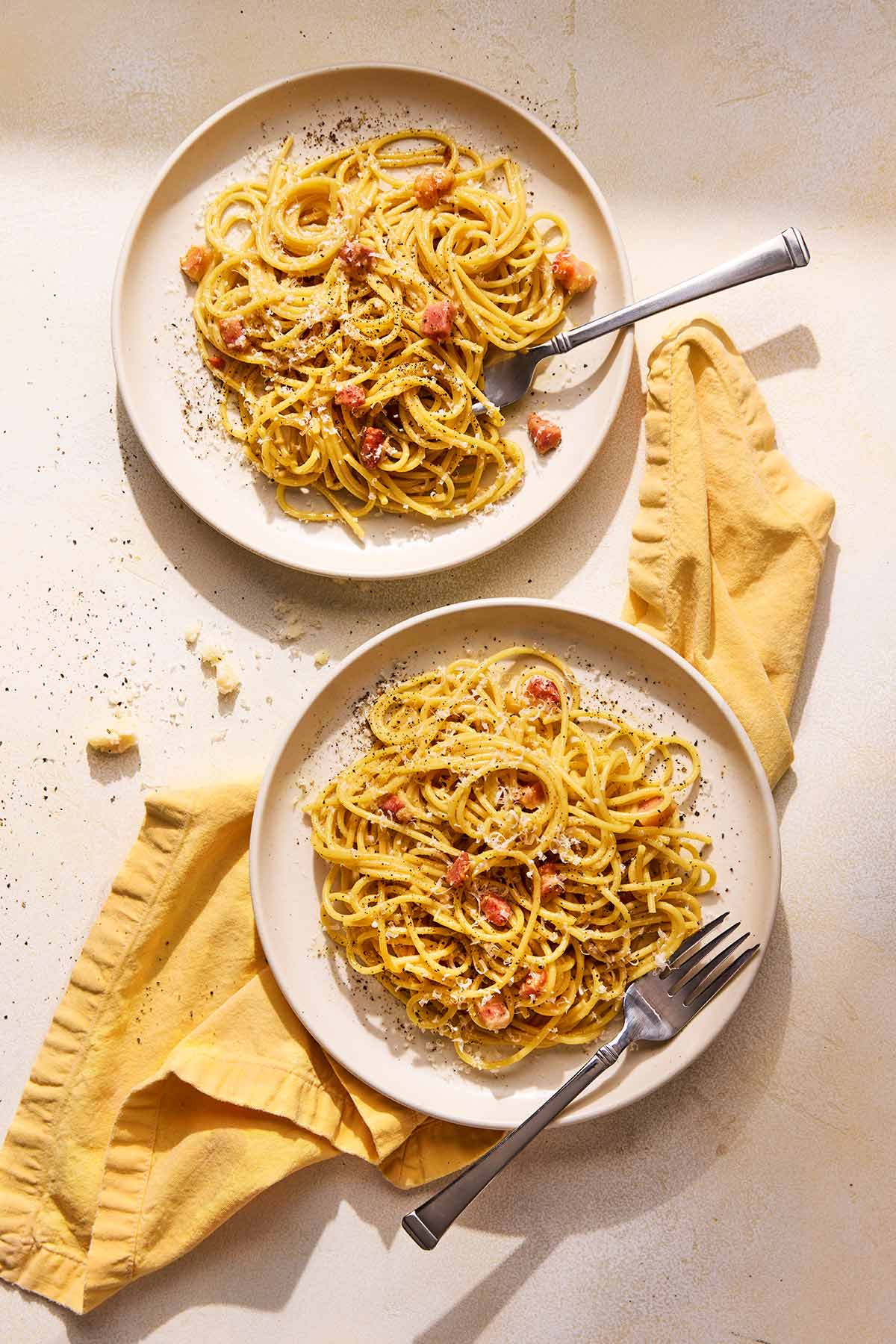
Write a Review
If you make this recipe, or any dish on LC, consider leaving a review, a star rating, and your best photo in the comments below. I love hearing from you.–David
Finally! Spaghetti alla carbonara the right way!! I lived in Italy for three years and would eat spaghetti alla carbonara every time we visited a restaurant. When I moved back to the States, no one made it right–except you!.
Sharday
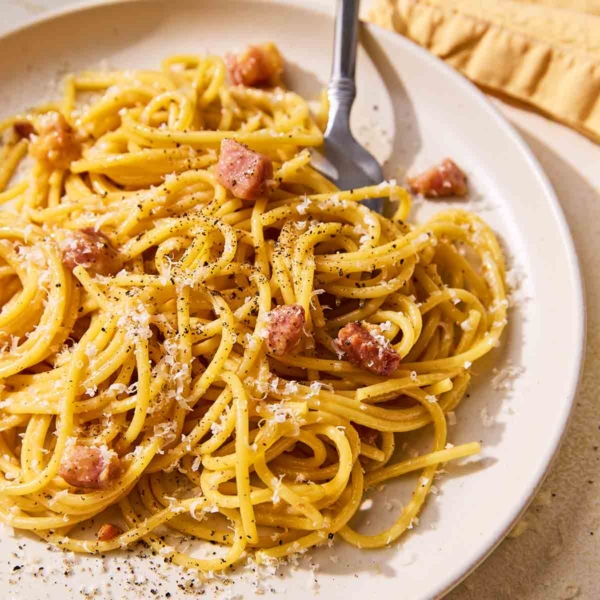
Spaghetti Carbonara
Ingredients
- 1 tablespoon extra-virgin olive oil
- 6 ounces thickly sliced guanciale, pancetta, or slab bacon, cut into 1/4-inch (6-mm) cubes
- 2 tablespoons kosher salt
- 1 pound spaghetti
- 3 large eggs plus 1 large egg yolk, well beaten
- 3/4 cup grated Parmigiano-Reggiano, combined with 1/4 cup grated pecorino Romano
- Freshly ground black pepper
Instructions
- Grab your largest skillet and place it over medium heat. Pour in the olive oil and wait for it to ripple.
- Toss in the guanciale (or pancetta or bacon) and cook, stirring often, until crisp. Slide the skillet off the heat.
- Meanwhile, in a large pot, bring 6 quarts of water to a boil. Add the salt and spaghetti and cook, stirring to prevent the strands from clumping, until al dente.
- Working quickly, grab big bunches of cooked spaghetti with tongs and add them to the skillet with the guanciale.
☞ TESTER TIP: The cooking water that dribbles from the pasta will make the sauce silky while not cooking the eggs.
- Immediately add the eggs and half the cheese to the skillet and toss well. If the dish isn't as creamy as you'd like, add a small ladleful of the cooking water.
- Sprinkle generously with pepper and serve at once. Pass the remaining cheese at the table.
Notes
- Raw egg warning–Remember, this spaghetti alla carbonara recipe contains raw eggs. So, use care if making the dish for the very young, the very old, the very pregnant, or the very immuno-compromised. For the rest of you, sit down to this outrageously easy and traditional Italian carbonara recipe with gusto.
- Get prepped–Have all your ingredients prepped and ready to go, as this pasta dish comes together in just minutes once you begin cooking.
- Storage and reheating–Store leftover spaghetti carbonara in a sealed container in the refrigerator for up to 2 days. Reheat in a skillet over low heat until heated through. Add a splash of water (or pasta cooking water) to loosen the sauce, if needed.

An LC Original
View More Original RecipesNutrition
Nutrition information is automatically calculated, so should only be used as an approximation.
Recipe Testers’ Reviews
It was a rainy night, and I had no desire to brave the elements and hit the grocery store. This spaghetti alla carbonara recipe allowed me to use ingredients I had on hand—with one minor substitution of slab bacon for pancetta—and create an easy, soul-satisfying meal.
The eggs, cheese, and pasta water formed a rich creamy sauce that, when combined with the crisp bacon, made for a real wow factor.
Don’t be scared of traditional spaghetti carbonara! Just mix the pasta quickly once you add the eggs and add the hot pasta water slowly.
I’ll never be able to eat the versions served with cream in restaurants again. This was delicious, so easy, so fast (!), and is ideal as a pantry dinner. The longest part really is waiting for the water to boil!
This is one of those wonderful recipes that doesn’t require you to run out and buy a thing. Who doesn’t have pasta, cheese, and eggs lying around?
This spaghetti carbonara was so simple to make. It perfectly fits my cooking style—a handful of ingredients, simple preparation, and a great-tasting result. I’m most certainly adding this to my arsenal. It just doesn’t get much better than this creamy, porky bowl of pasta love. Great recipe!
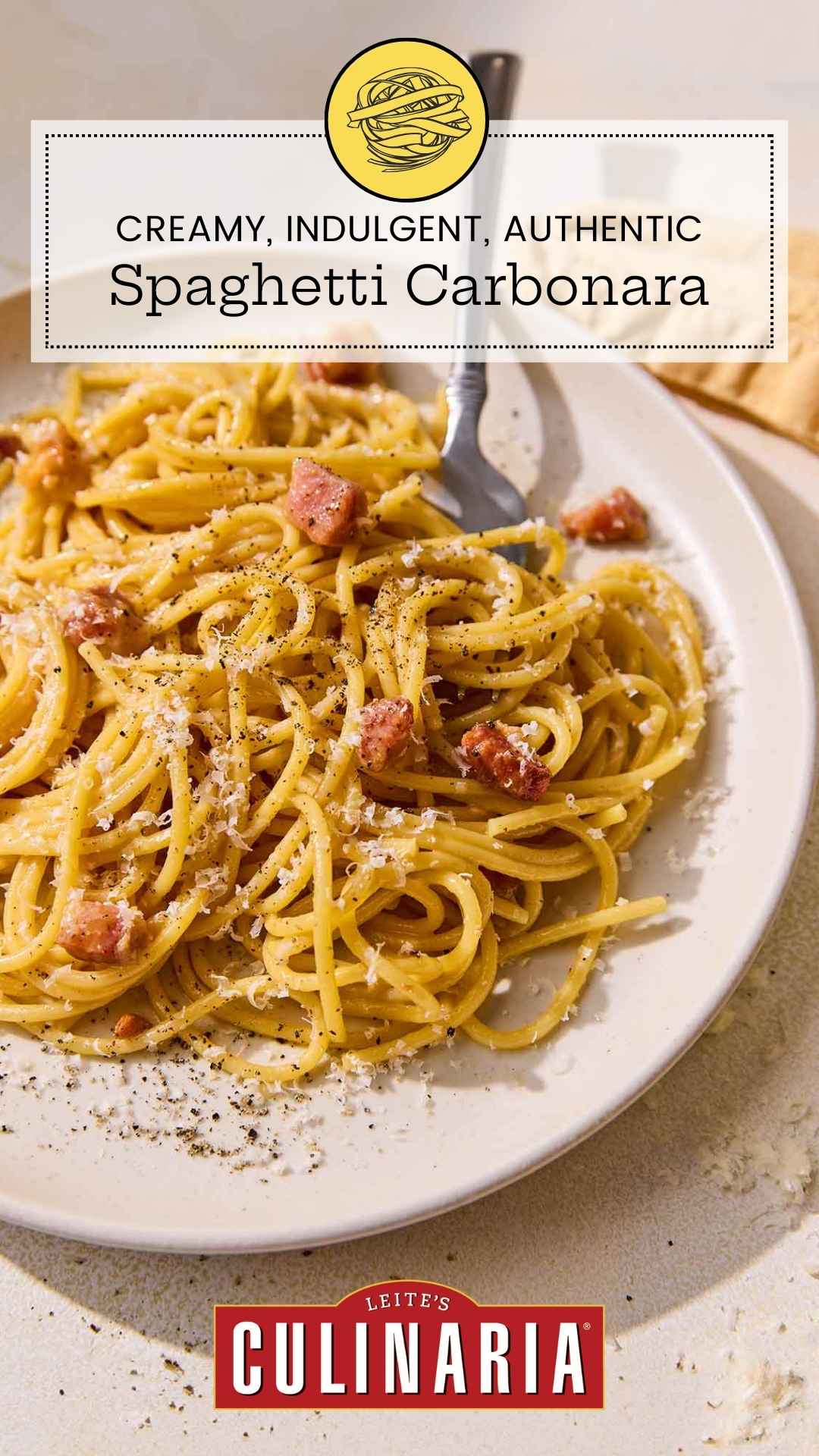
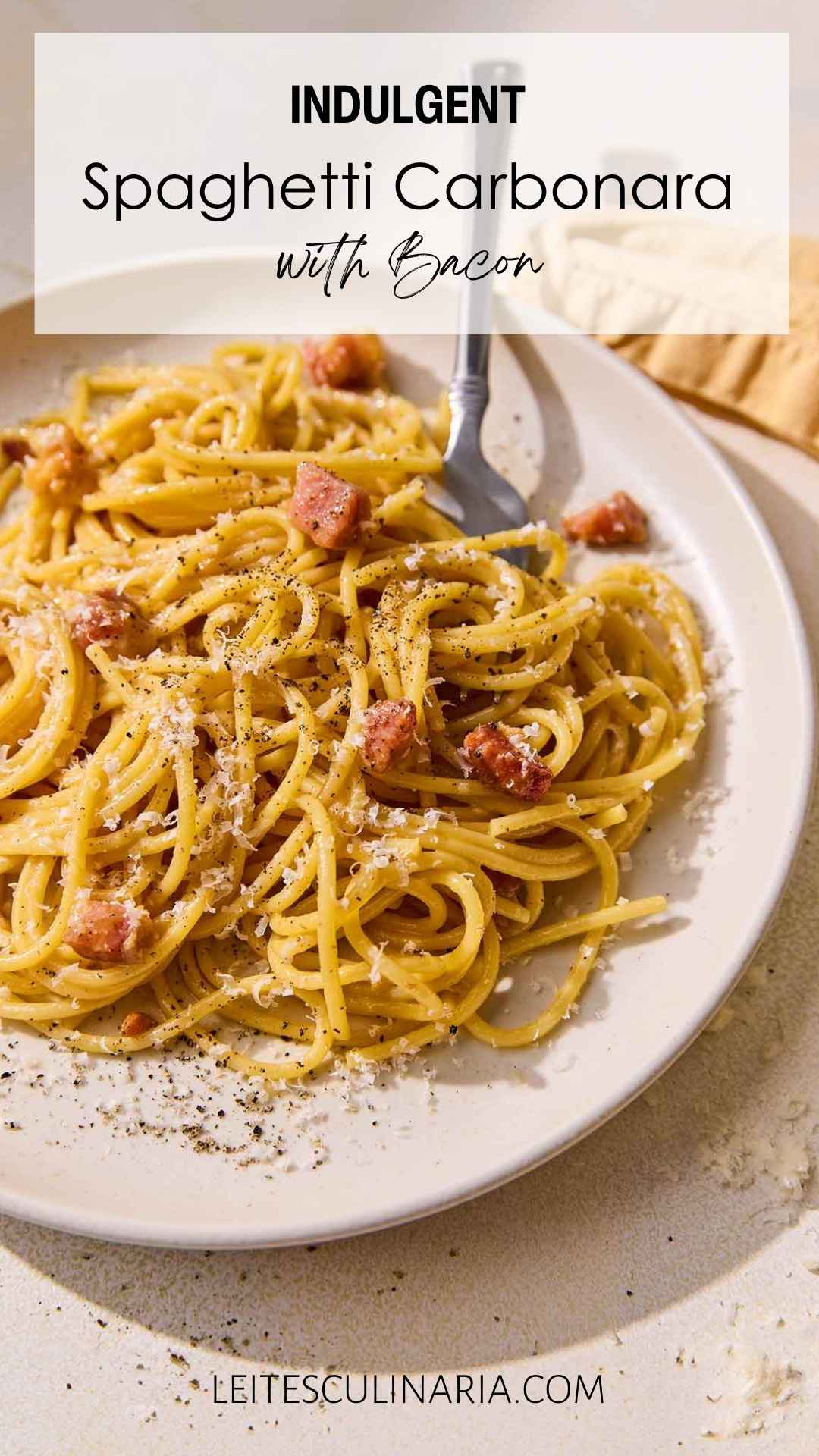

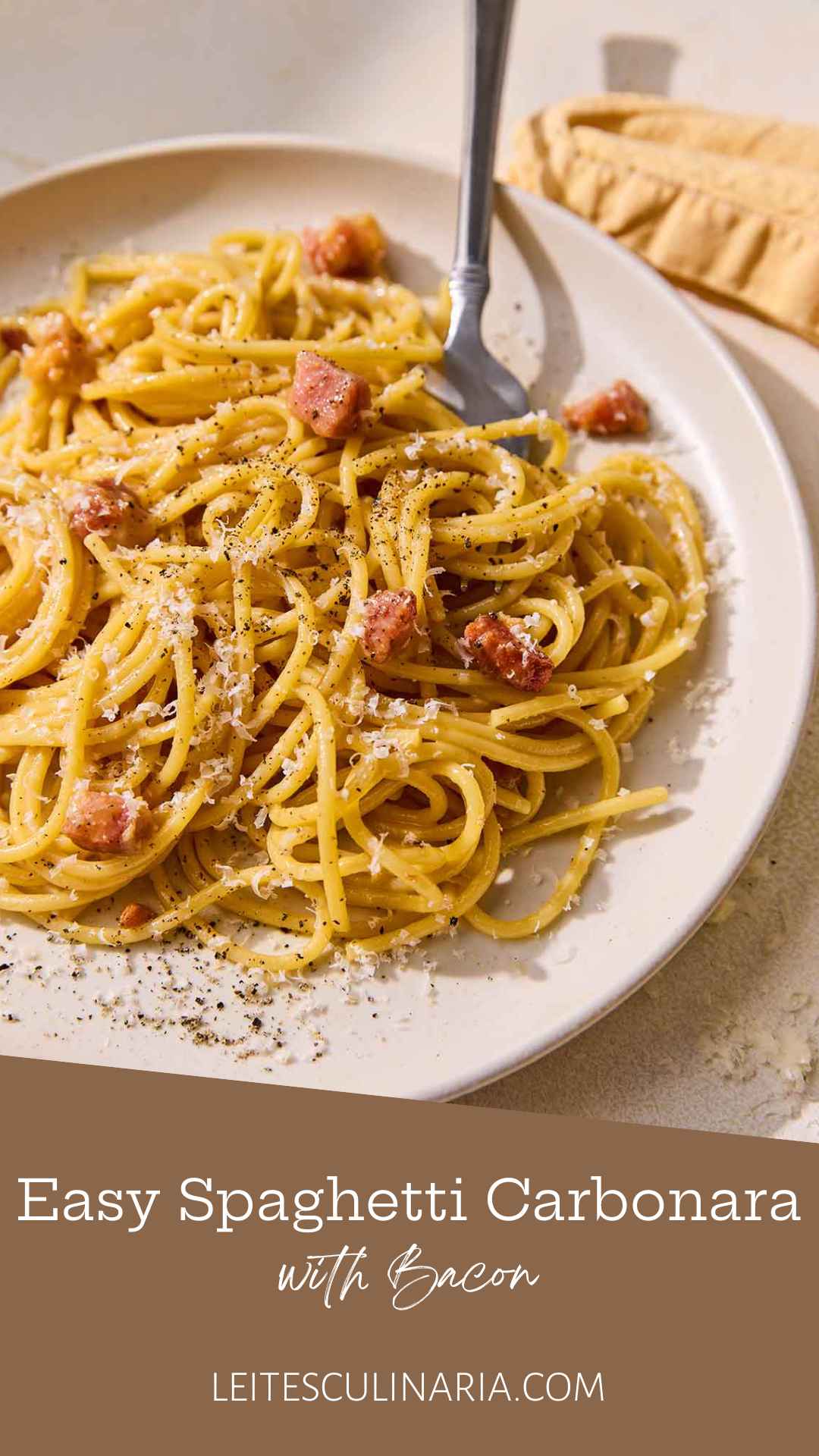
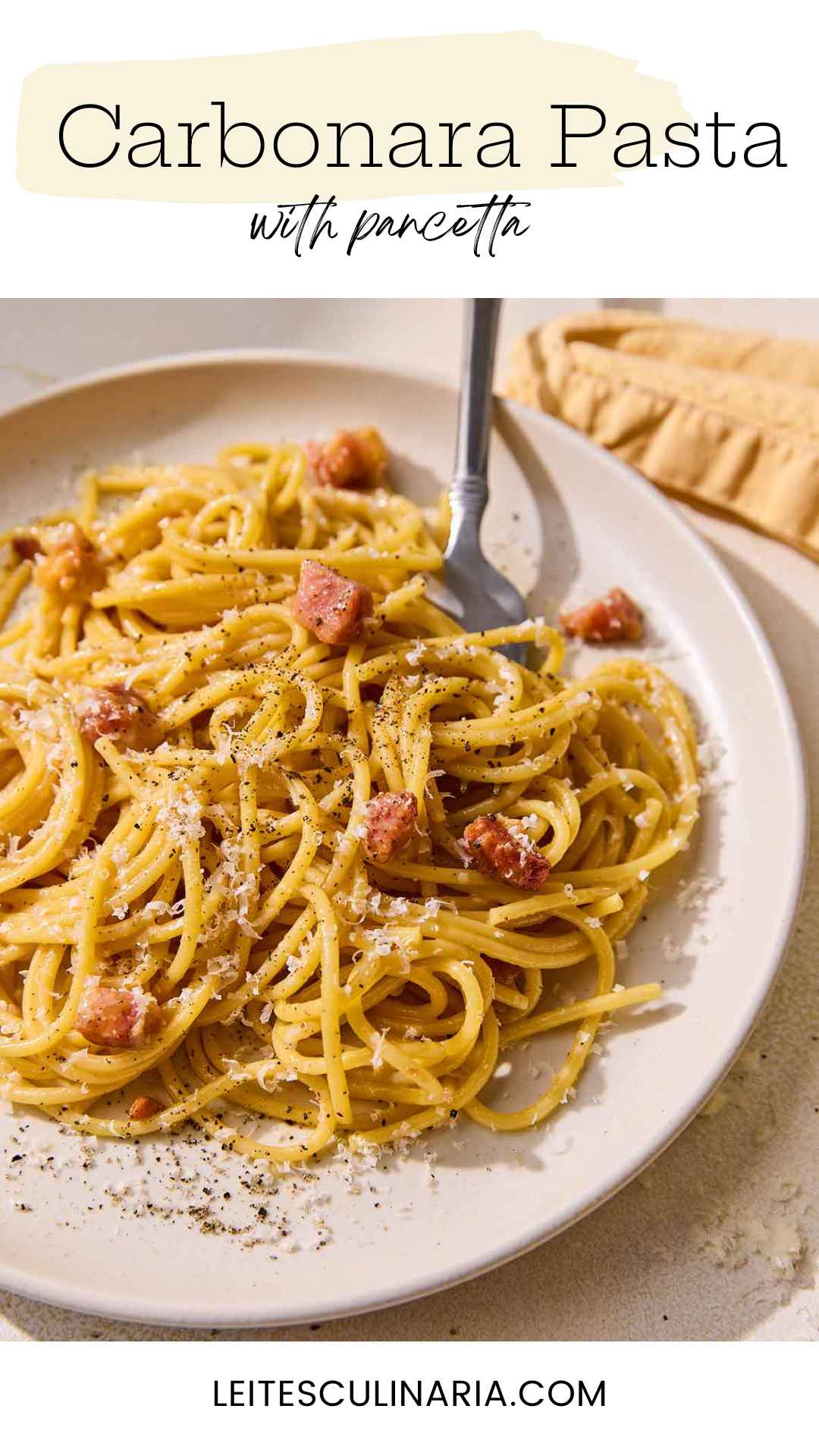
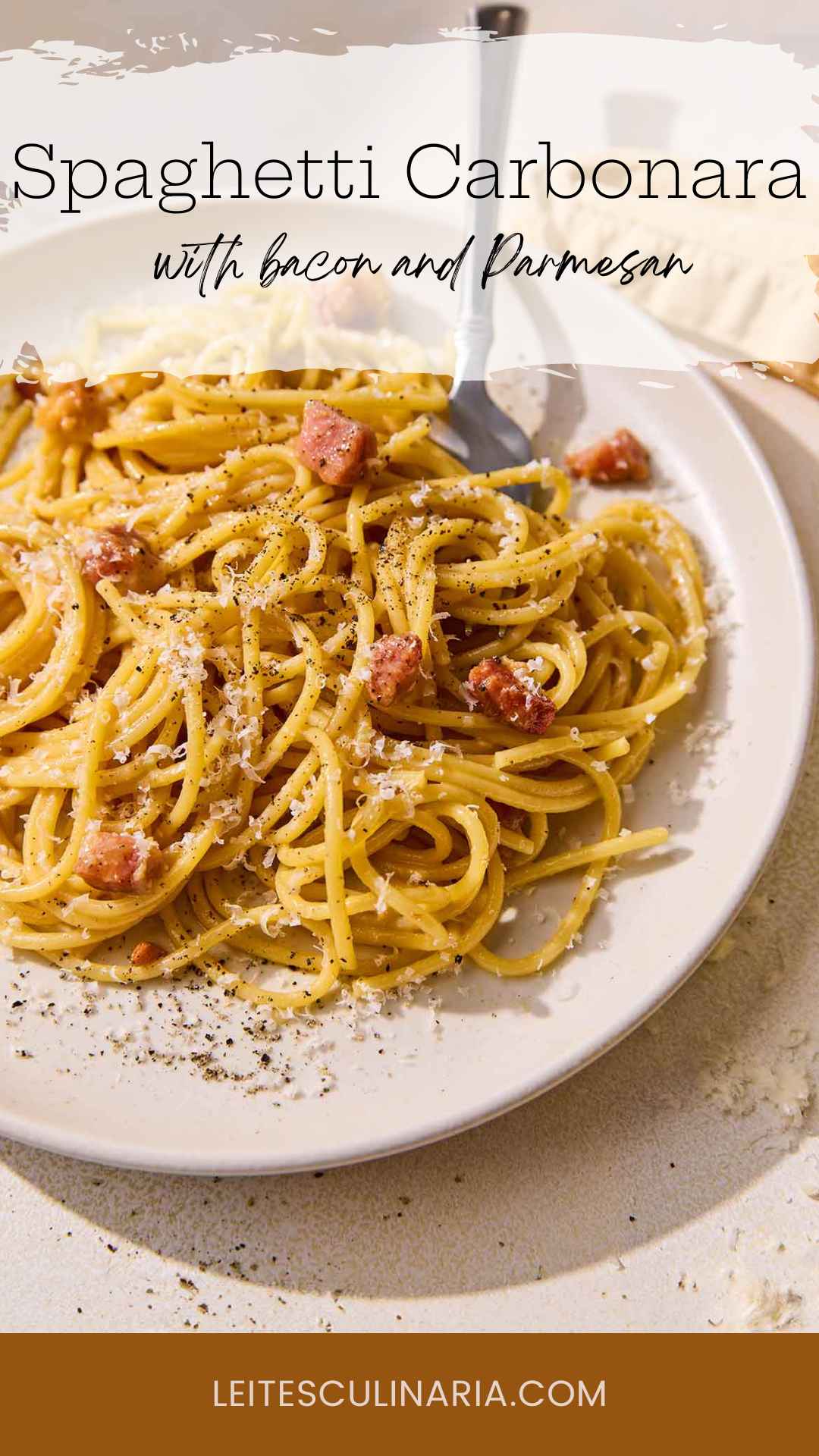
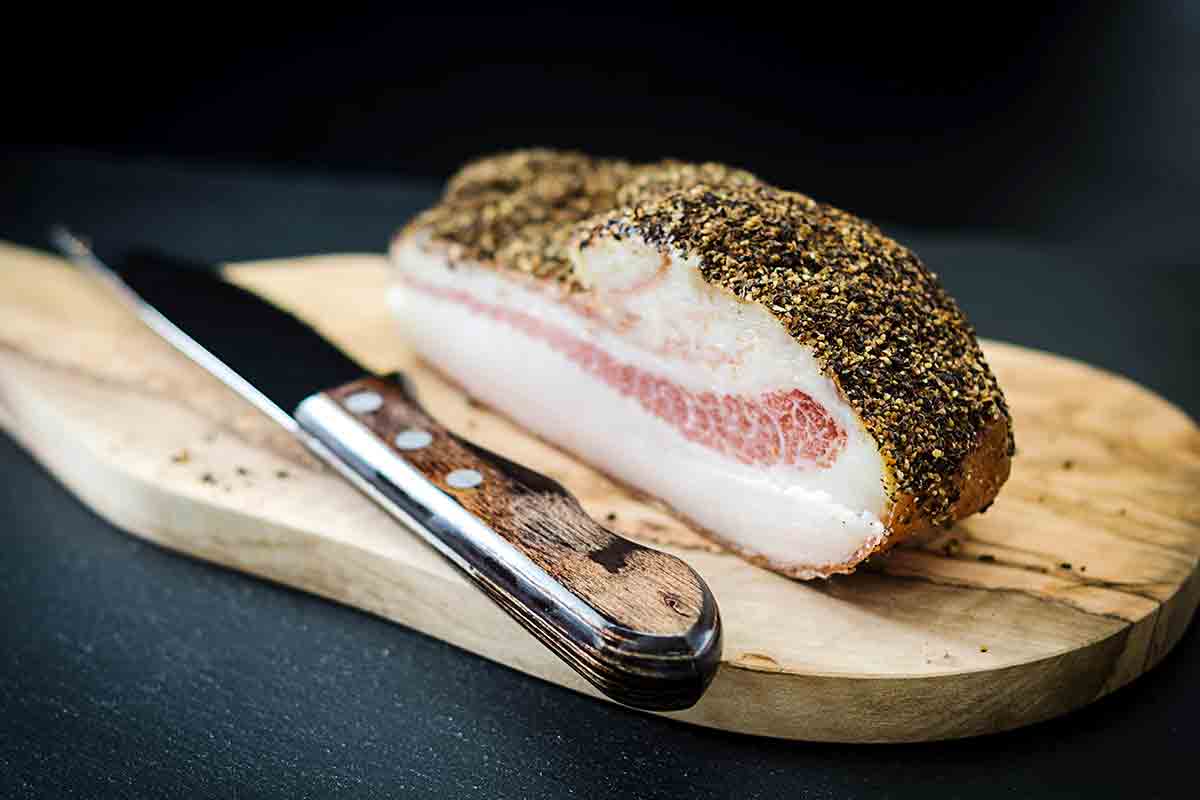
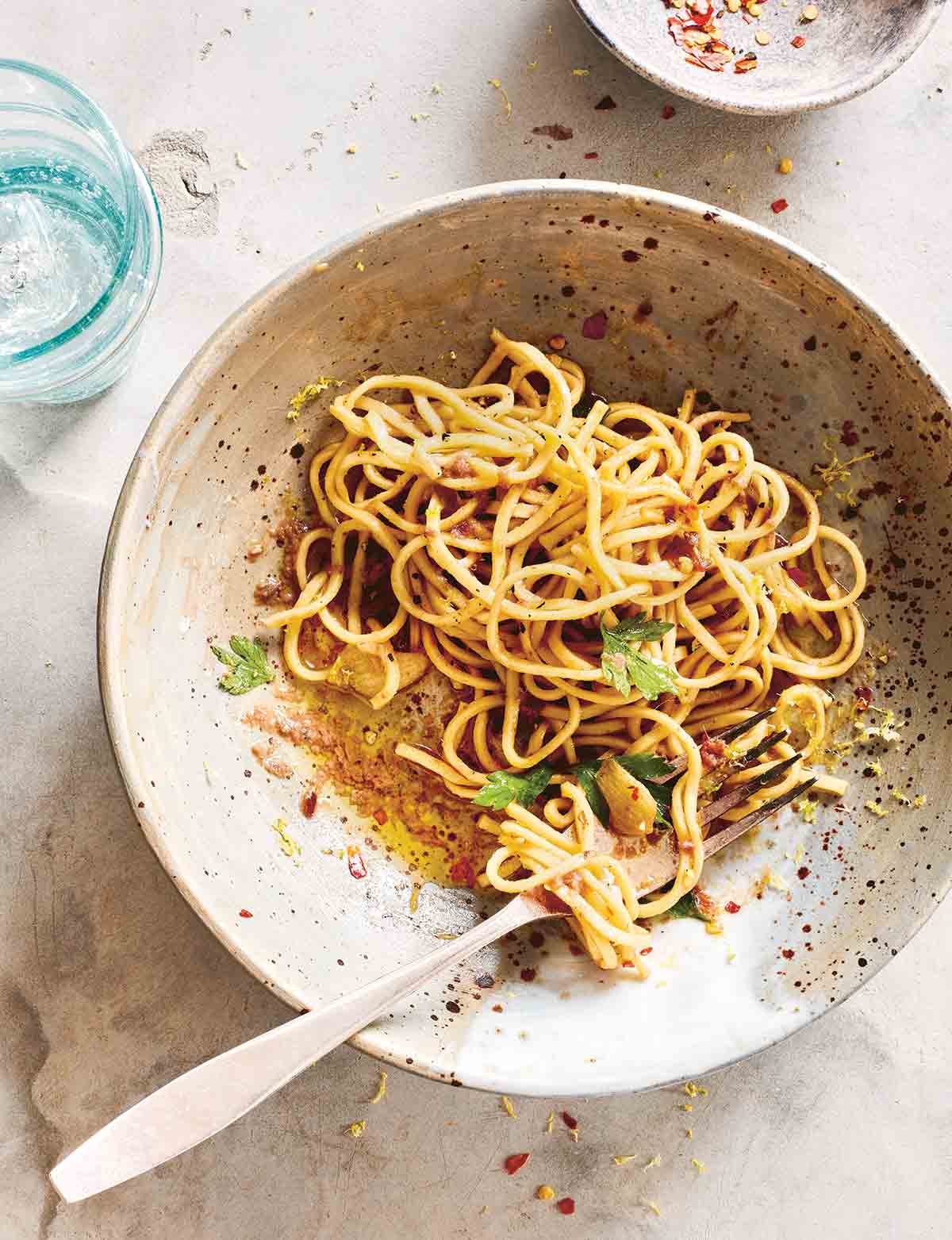
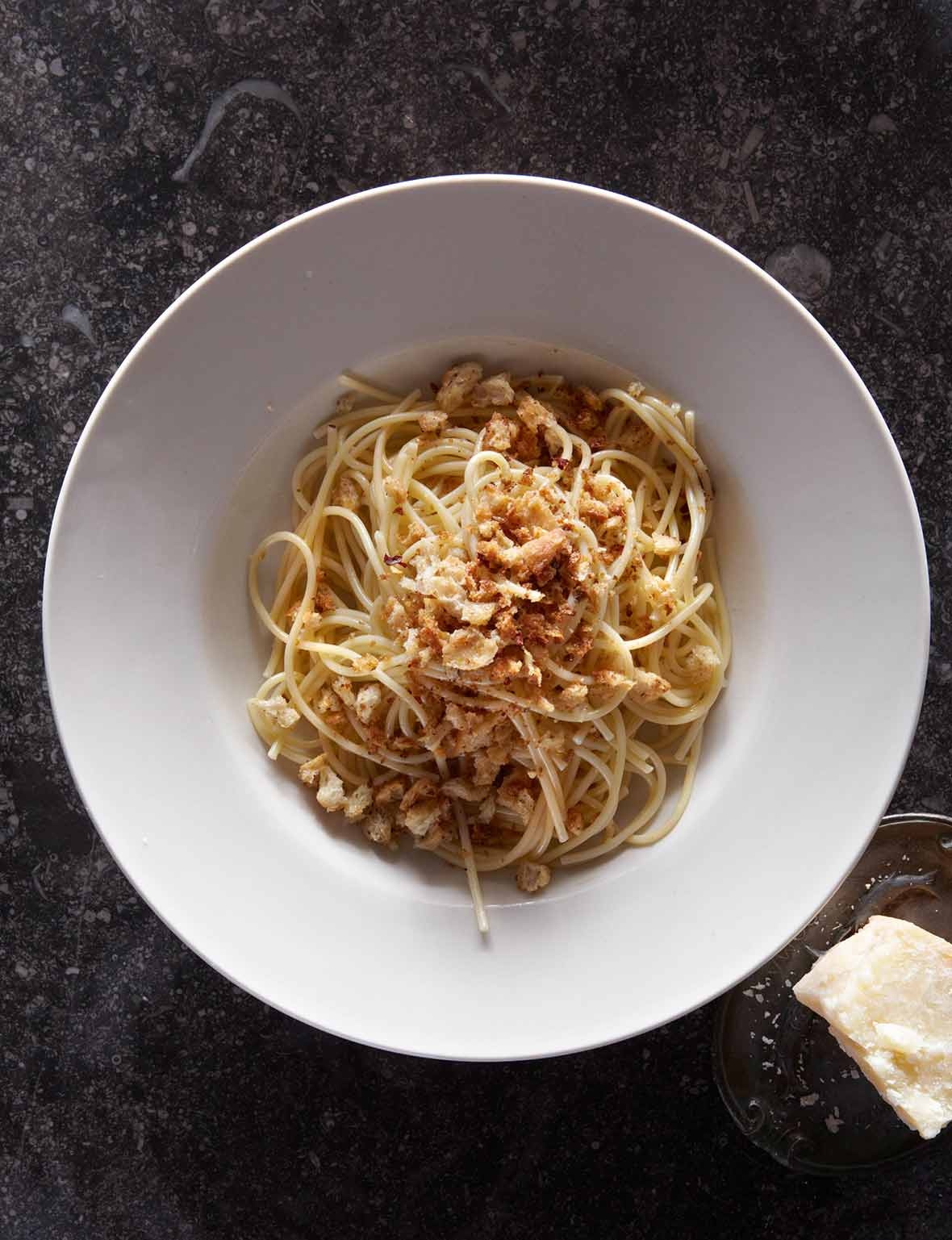
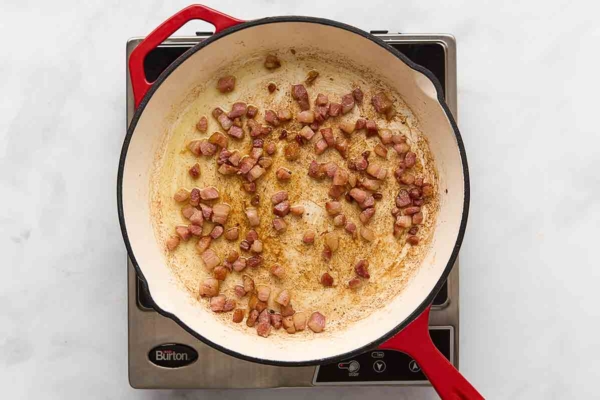
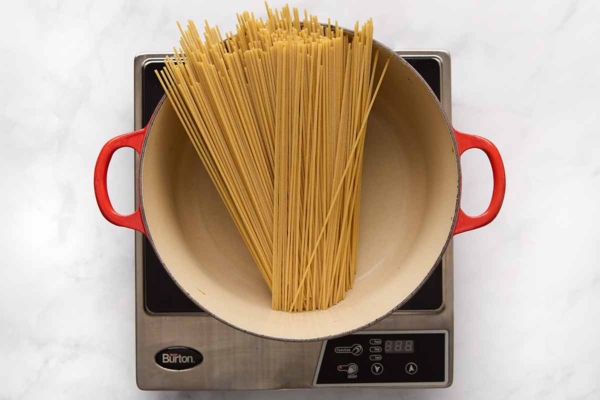
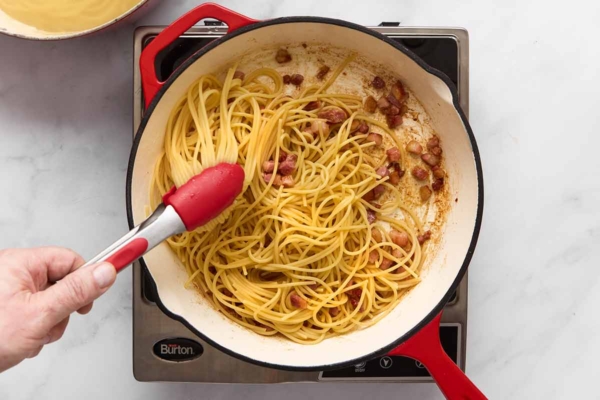
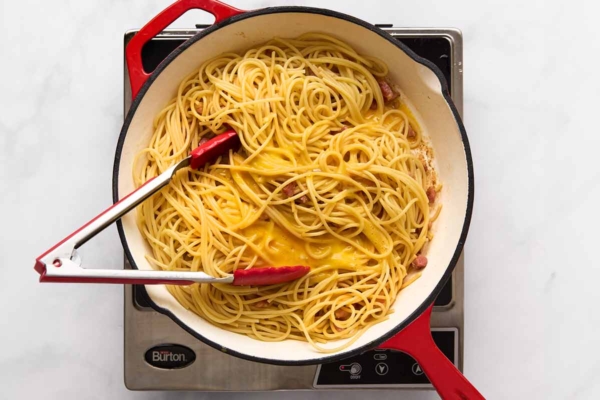
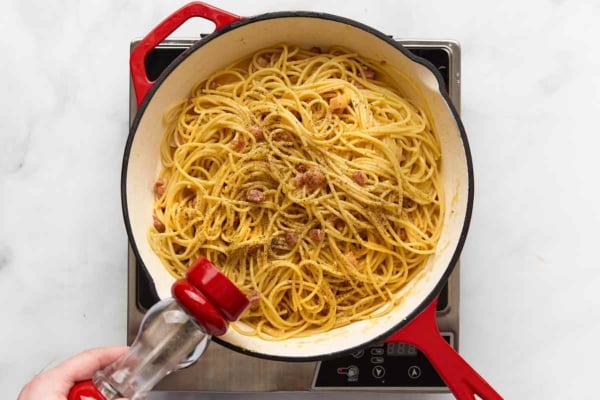











I will make these tonight replacing the pancetta with bacon. I have some smoked pork used on Brazilian Feijoada could I use this instead?
On a different subject. David, you have a recipe for pork and beans in your book, the New Portuguese Table. I was wondering if you have a recipe of authentic Brazilian feijoada. The history behind the dish is fascinating, the black beans give a special touch and the bay leaves just complete the ensemble. I was wondering if you would know where the tradition of serving it with orange and fried collard beans come from?
Hi Humberto, my name is Leticia, and I’m a Brazilian chef based in the US. David suggested I reply to you regarding feijoada. (Thank you, David).
To answer your spaghetti alla carbonara question, even though pancetta is unsmoked, yes, you can use any leftover smoked pork from a feijoada, and it will still have a strong enough flavor to stand to the carbonara sauce. (That is, if you have’t tried it already, sorry for being a day late.)
As for the feijoada, I agree with you, it is a fascinating dish, with lots of history behind it. Collard greens are most often served braised rather than fried. The tradition of serving oranges with feijoada is based on the idea of “cutting through” some of the fat, which is left in the beans from all the meats cooked in pot. Some Brazilians serve orange segments on the side; some throw an orange cut in half into the beans; some even squeeze fresh orange juice and add it to the beans. My theory is a little different: if I use a lot of salted and/or fatty meats, the beans will end up fatty anyway, and no amount of orange or juice will fix that. So I like to make another batch of black beans to serve. In other words, the beans that the meats are cooked in aren’t the same beans served. But, of course, it all depends on what kinds of meat you use and how fatty the beans get.
If you would like more info on the subject, my cookbook The Brazilian Kitchen is coming out this February and features a great recipe for feijoada. If you have more questions, please feel free to contact me leticia@chefleticia.com.
Thanks Leticia
I did the recipe with smoked pork and my wife loved it. I am sure going to check the Brazilian Kitchen book as I am Brazilian as well and I love to cook.
Thank you.
great recipe for an italian favorite, david! however, the real reason i’m commenting is because your title is so clever and i wanted you to know that i appreciate such brilliance. 🙂
Well, thank you, Grace. A great way to start a cloudy, raining Monday morning.
This is comfort food at its finest. I have a similar recipe for fideo. Takes me home every time I prepare it. Thanks, David.
My pleasure, Judith.